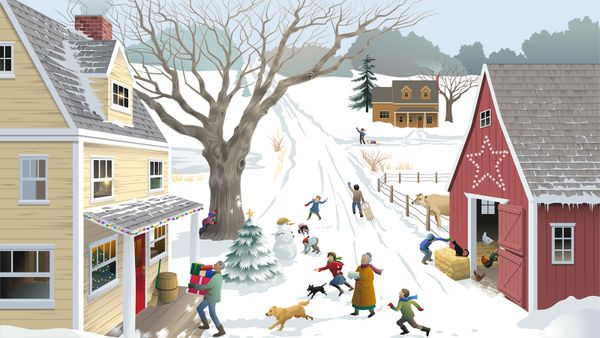Christmas Traditions in Sweden

It is dark, cold, and snowy in Sweden in December. The days are short and the nights long. Families begin the Christmas season by attending church on the first Sunday of Advent, which is the fourth Sunday before Christmas. The children count the days from the first day of December until Christmas with an Advent calendar. Each morning, they open a flap in the calendar's Christmas scene to see the charming picture behind it.
But the Christmas festivities really begin on December 13 with St. Lucia's Day, which celebrates the patron saint of light. The eldest daughter gets up before dawn and dresses as the "Queen of Light" in a long white dress. She wears a crown of leaves and lighted candles. Singing "Santa Lucia," the Lucia Queen goes to every bedroom to serve coffee and treats to each member of the family. The younger children in the family help, too.
Advertisement
Many families go to the Christmas market in the old medieval section of Stockholm to buy handmade toys, ornaments, and candy. Gift-givers like to seal the package with sealing wax and write a special verse that will accompany the gift.
The whole family helps to select the Christmas tree just a day or two before Christmas. Then they use papier-mache apples, heart-shaped paper baskets filled with candies, gilded pinecones, small straw goats and pigs, little Swedish flags, glass ornaments, and small figures of gnomes wearing red hats to decorate the tree.
The delightful smells of gingerbread cookies in the shape of hearts, stars, or goats fill the house. Many families set out a sheaf of grain on a pole for hungry birds.
At the midday meal on Christmas Eve, families follow the tradition of "dipping in the kettle." To remember a time when food was scarce in Sweden, the family eats bread dipped into a kettle of thin broth.
After this modest beginning, they enjoy a bountiful smorgasbord of lutefisk, which is dried fish, Christmas ham, boiled potatoes, pork sausage, herring salad, spiced breads, and many different kinds of sweets. It is said that whoever finds the almond in the special rice pudding will marry in the coming year.
After dinner, the Christmas tree lights are lit. Then the Jultomten, the tiny Christmas gnome, comes on a sleigh drawn by the Christmas goat, Julbokar. In some families, a friend or family member dresses up in a red robe and wears a long white beard to bring toys for the children. In other families, the Jultomten's gifts are left beneath the tree. After the gifts are opened, the family dances around the tree singing a special song.
In the predawn darkness of Christmas Day, candles illuminate every window. Bells ring out, calling families to churches lit by candlelight. Back home again, the parents kindle a blaze in the fireplace to light the darkness. The following day is Second Day Christmas, a day of singing carols.
On January 5, the eve of Twelfth Night, or Epiphany, young boys dress up as the Wise Men and carry a lighted candle on a pole topped with a star. These boys go from house to house singing carols.
Then on St. Knut's Day on January 13, there is one last Christmas party. The grown-ups pack away the Christmas decorations while the costumed children eat the last of the wrapped candies left on the tree. Then out goes the tree to the tune of the last song of Christmas.
No two countries celebrate Christmas exactly the same way. But while people around the world might have different traditions, Christmas is always observed with a sense of wonder and reverence, with friends and family gathered. That's a Christmas tradition we all share.

